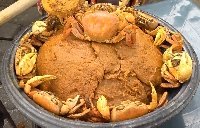Nutrition
Kaaweku

Kaaweku
Kwaaweku is a staple food for royals in Ada. The name ‘Kaaweku’ is derived from two syllables – Kaawe which means crab in the Ada language and ‘Ku’ which is taken from ‘banku’ because of its preparation which is similar to that of banku.
In other languages, this food made from roasted corn flour and palm nut soup has different names with the most common being ‘Apapransa’ as it is called by the Akans. In the Ewe language, it is called, Dzemkpl3, and in Ga, it is called ‘Akplijii’.
Ingredients
-1kilogram of palm nut extract
-2 large onions
-4 large peppers
– 3 large tomatoes
-Two tablespoonfuls of grinded ginger
-Two tablespoonfuls of garlic
– Half cup of roasted corn flour
– Fish/meat
-Momone
-Two tablespoonfuls of powdered shrimps
-Smoked salmon
-3 large crabs
Three tablespoonfuls of salt
Preparation
-Prepare the meat or fish to be used
-Season with your choice of seasonings, add blended onions, garlic, ginger if preferred
-Add salt to taste
-Allow fish/meat to steam for about 5-10 minutes
-Blend tomatoes and pepper
-Add to the steamed meat or fish
-Dilute palm nut extract with warm water and put on fire to boil.
– Dilute and melt the palm extract in warm water.
– Strain the palm nut extract to meat.
-Add crab after 5 minutes
-Allow soup to boil/ cook for 15- 25minutes (Normally ready when the palm oil separates to the top. Also, taste to see if the fresh taste of the palm is completely gone).
When Palm nut soup is ready, proceed to Kaaweku preparation
-Scoop about eight ladles into a separate saucepan
-Add about 9-10 tablespoonful of the cornmeal gradually and a spoonful at a time, stirring the mixture at the same time and continuously till desired pasty texture as achieved and all lumps are completely dissolved.
-Add a scoop of soup and allow to steam for a couple of minutes.
– Serve into your bowl, garnishing with the crab on top, and enjoy. Soure: Ghanafoods.com
Nutrition
Coconut brittle (Kube cake)

Coconut brittle is a popular local snack, made from shredded matured coconut and sugar.
Ingredients
-2 medium sized coconuts
-1 and ½ cup of sugar
-1 tablespoonful of salt
-2 tablespoonful of water
Preparation
Wash coconut, cut into pieces and grate or shred in a bowl
Leave grated coconut to dry
Put sugar in a pan to melt and add a pinch of salt to it (stir for five minutes)
Add grated coconut to the melted sugar and stir to get a stretchy mixture
Get a clean board and sprinkle a little oil on it
Pour mixture on board and mould with hands into round shapes
Nutrition
Garden eggs stew

-10 large garden eggs
– 4 large tomatoes
-2 large onions
– ¼ cup palm oil
– 2 tablespoonfuls of powdered pepper
– 340g smoked mackerel
– A kilogram of cowhide (wele)
– A kilogram of beef
– A clove of garlic
-A clove of ginger
-3 tablespoonful of salt
-1/4 of salted fish (momoni)
Preparation
-Wash garden eggs and cook for some time. (Grind or blend for a smooth texture)
Wash and cut onions, tomatoes, ginger and garlic and put in a blender
Put oil in a utensil on fire and add salted fish to it
-Add blended onion, tomatoes, ginger and garlic. (Let it cook for some time)
-Add grinded or blended garden eggs to the mixture fire
Add fish, wele, beef, salt to stew.







